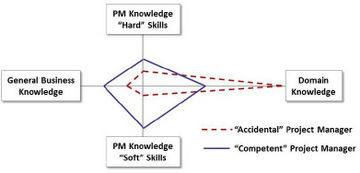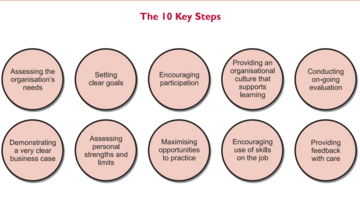EQ and Leadership Effectiveness
(→Apply EQ as a portfolio, program, and project manager) |
(→Apply EQ as a portfolio, program, and project manager) |
||
| Line 84: | Line 84: | ||
=== The 10 key steps === | === The 10 key steps === | ||
| − | [[File:wiki - billede 2. | + | [[File:wiki - billede 2.png|thumb|upright=2|The 10 key steps]] |
*Key steps to increase EQ in an organization <ref name="burgan"/> | *Key steps to increase EQ in an organization <ref name="burgan"/> | ||
*Start simple | *Start simple | ||
Revision as of 18:29, 9 April 2023
Mathias Ehlers Iversen, s174750
Abstract
Emotional Intelligence (EQ) is the ability to understand and manage your own emotions, as well as others’ emotions. EQ is increasingly becoming one of the most important attributes in the field of leadership. The ability to control your emotions as a leader is a crucial part of success and increases the effectiveness of leadership [1].
Emotional intelligence contains four key elements:
- Self-Awareness
- Self-Management
- Social Awareness
- Relationship Management
These four elements relate to different abilities associated with high EQ. The ability to control and apply these elements in leadership can be crucial for managers to increase effectiveness and productivity [2].
Leaders with a high level of EQ are seen to be more effective in achieving organizational goals, creating a positive work environment, and building winning teams. They are both great a developing themselves and others toward the direction of the goals in an organization. To apply EQ in leadership it is important to constantly develop and increase the level of the key elements.
According to the authors behind “EQ and the Bottom Line” they identified 10 key steps to develop EQ in an organization. These steps are in a variety of difficulty to apply within an organization and must be adapted to individual organizations. However, if applied correctly can be a vital driver for increasing organizational EQ and project performance [1] [3] [4].
While EQ is seen as a very valuable tool and the ability of leaders, it is important to acknowledge its limitations. The complexity of the concept and development of EQ requires effort, time, and dedication. Furthermore, all individuals are not equally skilled in EQ, and it can be very difficult to develop these skills for some individuals.
Contents |
Succeed as a leader with EQ
Emotional Intelligence (EQ)
- Theory about EQ
Emotional Intelligence further referred to as EQ, is theoretically described as the ability to manage and understand your own and others’ emotions as an individual person. It is increasingly being acknowledged as one of the most important attributes of a great leader or manager. A person associated with high EQ is often seen as being traditionally better at managing conflicts, connecting with their team members, creating a positive work environment, and building trust.
- The four key elements
The four key elements of EQ are self-awareness, self-management, social awareness, and relationship management. These elements are referred to as key in both applying and developing a high EQ. For an individual to experience success working with EQ it is essential to master the elements that involves both internal and external factors.
Self-awareness – This is the ability to understand your own emotions, weaknesses, strengths, behavior and rationality. It also includes skills in predicting patterns in behavior and the ability to exclude feelings in a situation of decision-making. Individuals who master self-awareness are excellent in identifying the emotional and rational mind and the triggers associated. They are exceptionally aware of their emotional triggers when they are in stressful situations to avoid making decisions based on their emotions.
Self-management – This is the ability self-manage your emotions and adapt to the a given situation based on your rational mind. It also covers great self-management skills concerning sudden changes in behavior or processes. Individuals with a high level of self-management are extremely good at adapting to negative changes and are very good at keeping a positive mind through stressful or tough situations. They are very good at balancing their emotional and rational mind to make better decisions.
Social awareness – This is known as the ability to understand and emphasize with the emotions of others. Furthermore, you are able to navigate effectively through social situations and deal with other perspectives than you own. Individuals with a high level of social awareness are excellent at listening, felling empathy, communicate effectively and resolve conflicts together with other people. They are great at being aware of social signs and building relationships with people. To build an inclusive and diverse environment, a high degree social awareness among managers is often required.
Relationship management – This is the ability to build and maintain healthy relationships, influence people, motivate others and managing conflicts. This involves communicating effectively, being able to negotiate, and collaborate. Individuals with a high level of relationship management are excellent at building trustful and inclusive relationships. They inspire others and are often seen as trustworthy individuals.
Controlling your emotions
The ability to control your emotions as an individual, is a very important aspect of Emotional Intelligence. It enables people to respond to given situations appropriately by effectively managing and balancing their emotions. It indicates a high level of EQ if you are able to be aware of both your positive and negative emotions and regulate them in an appropriate way. In this way, it is also very important to be aware of the aspects of positive emotions that broaden and negative emotions that narrow.
- Positive emotions - Broadens
Supporting resiliency - Improving our thinking - Undoing negative emotions - Building new skills - Creating psychological capital
- Negative emotions - Narrow
An indicator of potential threats - Calls attention to an issue - A mechanism of learning
EQ and Leadership
- Leading by being emotional
Emotional Intelligence (EQ) and leadership are closely related, as leaders with high EQ are often seen as more effective and successful. Leaders with high EQ are able to understand and manage their own emotions, as well as the emotions of others, and use this knowledge to build strong relationships and create a positive work environment.
- Why high EQ is associated with great leadership qualities [5]
High EQ is associated with great leadership qualities for several reasons. Leaders with high EQ are able to empathize with others, build strong relationships, and communicate effectively. They are also able to manage conflict and respond to feedback in a constructive manner. These skills are critical for building a positive work environment, fostering innovation and creativity, and achieving organizational goals.
How to self-develop EQ
- Never stop developing and learning
Never stop developing and learning is a critical aspect of developing EQ and effective leadership. One methodology to develop EQ is to start by being human. This means not isolating oneself or becoming disconnected from others.
- Self-Management
Apply EQ as a portfolio, program, and project manager
Accidental versus Competent Project Manager
- The Accidental Project Manager
- The Competent Project Manager
Increase effectiveness and productivity
Leadership effectiveness
- Connecting [6]
- Social awareness
- Engagement
Organizational productivity
- Increasing the bottom line
The 10 key steps
- Key steps to increase EQ in an organization [7]
- Start simple
Increase project performance
- Vulnerability
- Creating a safe environment
- See people as individuals
- Proven studies and results
Conclusion
Limitation
References
- ↑ 1.0 1.1 Bharwaney. G, R.Bar-On, A. MacKinlay, EQ and the Bottom Line, pp. 14-16, (EI World, 2011), Available at: http://www.eiconsortium.org/pdf/Bharwaney_BarOn_MacKinlay_EQ_and_Bottom_Line.pdf (Accessed: 12 February 2023).
- ↑ Thompkins. S, Emotional Intelligence and Leadership Effectiveness: Bringing Out the Best, (Center for Creative Leadership, 2022), Available at: https://www.ccl.org/articles/leading-effectively-articles/emotional-intelligence-and-leadership-effectiveness/ (Accessed: 12 February 2023).
- ↑ Rechtfertig. G, Emotional intelligence and key principles to increase your capacity to succeed, (PMI® Global Congress, 2010), Available at: https://www.pmi.org/learning/library/emotional-intelligence-develop-abilities-skills-6628 & https://www.slideshare.net/captsumit/emotional-intelligence-and-key-principles-to-increase-your-capacity-to-succeed (Accessed: 19 February 2023).
- ↑ Casper. C.M, Using emotional intelligence to improve project performance, (Project Management Institute Annual Seminars & Symposium, 2002), Available at: https://www.pmi.org/learning/library/emotional-intelligence-improve-project-performance-1019 (Accessed: 19 February 2023).
- ↑ Berridge. G, High EQ: The Most Desirable Leadership Tenet of Them All, (N2Growth, 2022), Available at: https://www.n2growth.com/high-eq-desirable-leadership-tenet/ (Accessed: 19 February 2023).
- ↑ El Mokri. M, Emotional intelligence - an appropriate means to enhance team effectiveness?, (Project Management Institute Global Congress 2008), Available at: https://www.pmi.org/learning/library/appropriate-means-enhance-team-effectiveness-neurological-8361 (Accessed: 9 April 2023).
- ↑ Burgan. D. S. & Burgan. S. C., Understanding emotional intelligence for project management practitioners, (Project Management Institute Global Congress 2012), Available at: https://www.pmi.org/learning/library/understanding-emotional-intelligence-pm-practitioners-6023 (Accessed: 9 April 2023).

